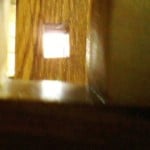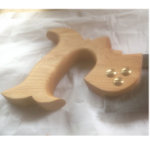How square should a square be?
Welcome! / Forums / General Woodworking Discussions / Tools and Tool Maintenance/Restoration / How square should a square be?
Tagged: combination square, square, stanley, tool
- This topic has 33 replies, 20 voices, and was last updated 9 years, 8 months ago by
kodi.
-
AuthorPosts
-

Hi , Matt
Tolerance -you said ? That matters on what you are working with – and who are you asking .
These meanings are different for a carpenter , mechanic ,cabinet-maker, astronome.
But – thumb’s rule are the numbers of Pitagora [Pythagoras] in a triangle : 3,4,5 – hence , the tolerance -and resolution is how accurately can -we measure -them.
It is hard to believe that you have got 3.5mm distance , please , double – triple check.
Please consider the attached file… if I am not too late…

 22 March 2013 at 8:02 pm #9749
22 March 2013 at 8:02 pm #9749Great diagram too, thanks, I shall be checking it like that tomorrow 🙂
24 March 2013 at 8:48 pm #9773FYI: I did as suggested (though I used clamps onto some spare hardboard rather than screwing a rule to some MDF – same result, immovable straight edge).
The square is off by 3mm at 240mm extension – half a millimetre less than I’d thought, but still, seemingly, a heck of a lot off.

Hi , Matt. If we are talking about (http://www.diy.com/nav/fix/handtools-storage-workwear/handtools/measures-levels/measures/-specificproducttype-squares/B-and-Q-300mm-Combination-Square-11247670?skuId=11758375)
(I’ve just googled this B&Q and found -out lots about. No comment.)
Just in case you sense a challenge in that 90 degrees ….) so what should I do to make -it square , before disposal?
1. CHALLENGE : I observed that the error is consistent , so when you take out the ruler , the aluminium cast body should present a clean-flat-straight groove / sliding channel.(Dirty -clean -it , and clean the steel rule -too. By -the way : is the ruler straight ?)
1.1-If there are some setting nibs , one or two , I’d follow the steps pointed by boyce and @agaudet , but verrrry gently (this might take several attempts.) This should do.
1.2.If there are no factory setting nib(s) , I’D MAKE ONE , using a sharp nail or a narow chisel , a good vise and a responsive … hammer. It should be solid enough for a long time stability.Then go to 1.1.
Still feel the challenge ?
2. I would thicken the horizontal arm with a -say 2-3 mm flat plate (this should be 1/8 th-of-an-inch) aluminium or hardwood (mind the grain) using an adhesive -and responsively flat -finish its surface (150 -300 grits) until my combi-square ‘boils’ at 90 degrees.THIS MUST DO.
I’m sorry for your time ( and my poor English).
Good luck , and as Master said , somewhere , once : ‘keep persevering !’

Matt, sorry to hear it was out that much. I don’t know where you live but take a look at these engineer squares lee valley sells. They arent combination squares but the 6 inch or 8 inch would at least get you going.
http://www.leevalley.com/en/Wood/page.aspx?p=32601&cat=1,42936
 2 April 2013 at 10:09 pm #10409
2 April 2013 at 10:09 pm #10409You must have a good square if not errors will occur.
A lot of woodworkers now turning to engineer squares Moor and Wright, Starret and the like are good as a refference. 6″ about £30
A good combination square are so handy. I have a 400 mm combination was not that expensive £25 made in the USA but spot on also an old Stanley 300 mm combo they probably about £25 now to buy
I have a couple of rosewood and brass stock squares look loverly but never found them to be that great for square.
Anonymous10 December 2013 at 4:48 pm #23528The man in this film does not know what he is taking about.
 10 December 2013 at 5:13 pm #23533
10 December 2013 at 5:13 pm #23533@clearwatertom Welcome Tom , which man are you talking about /why
 10 December 2013 at 5:46 pm #23536
10 December 2013 at 5:46 pm #23536I bought an old Starrett Combination square off ebay and was disappointed to discover it wasn’t quite square. I thought it was a loss until I read about the nibs. I got some needle files, took my time, and wound up with a perfectly square Starrett for very little money.
Start with wood with a truly flat side, think about what you’re doing, and go slow testing frequently and it’s really pretty simple to fix.
John

Square is only as square as square needs to be… Sorry I had to play with a few words… I personally own several good quality squares due to my being a Machinist/Engineer. Tolerance is up to the user. How much is acceptable to you? Given all of the suggestions so far and if the surface you are grounding your square against is flat then I probably would look at replacing this square. You can get a cheap square that is pretty accurate or even make one for yourself. American Woodworker Magazine had a pretty good article on making squares a few months ago. I’ll dig out my copy when I get in the shop later today and post the issue and date.
 10 December 2013 at 6:43 pm #23540
10 December 2013 at 6:43 pm #23540Thanks for the video Ken. Lots of good ideas there.
Back when I was buying old tool boxes I came across at least a half dozen try squares with the wood face and metal arm. And not one of them was even reasonable close to square and not one of them could be saved. I don’t know if humidity was the cause but I do know it put me off them permanently. I’ve also had three combination squares in that time and two of the three were perfectly square as far as I could test them and the third was an easy fix.
I have been looking for an all metal try square for checking my face and edge sides. I wanted something with a broader registration face than my combination square. After watching that video I think I’ll price some “engineer’s squares” instead.
I’ll also start testing my squares regularly. I can see how a combination square could wear its way out of square over time and I wouldn’t notice.
John
-
AuthorPosts
- You must be logged in to reply to this topic.
